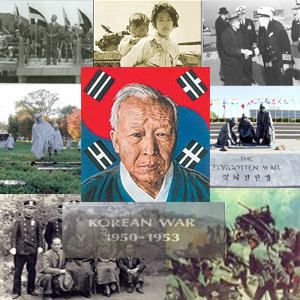
 |
Syngman Rhee |
| HOME |
 |

Syngman Rhee or Lee Seungman was born in Kaesong, Korea, on March 26th, 1875. Rhee developed an interest in politics. In 1897, he was imprisoned by the Yi Dynasty for protesting against the monarchy. In 1905, he was released from the prison. Then he continued his education in the United States. He graduated in 1907 from The George Washington University. In that institution he was a member of the prestigious Enosinian Society. Also from Harvard University in 1909, he received a Master of Arts. Rhee continued at Princeton University in September of 1909. He obtained a Ph.D. in Politics and International Law on June 14, 1910 at the age of 33. During the Japanese occupation of Korea (1910-1945), Rhee was elected as the president of the Korean Provisional Government in exile. The defeat of Japan ended the Second World War. It would then allowed American and Soviet troops to enter Korea. In 1948 the Soviet Union set up a People's Democratic Republic in North Korea. At the same time the United States helped establish the Republic of South Korea. Still in 1948, after Korea was liberated, Rhee returned to Korea. He then became the first president of South Korea. He also received an unofficial support of the United States. In June 1949 the United States Army began to withdraw from South Korea. The Korean War broke out in June 25th, 1950, when Kim-Sung, led an army and surprisingly attacked South Korea. He was the communist dictator of North Korea. North Korean army was able to take over the South Korean capital, Seoul. United Nations recommended that troops should be sent to defend South Korea. Unfortunately, since the Soviet Union was having a great influence in the Security Council of United Nations at the time, the recommendation was not approved. Then 15 nations agreed to send troops to Korea under the command of Douglas MacArthur. During the time of crisis in the Korean War, Rhee commanded the citizens of Seoul to remain in the city. He himself was already on his way to refuge. Rhee damaged his reputation because of his command. His decision to cut the bridges on the Han River prevented thousands of citizens from escaping the Communist rule. The U.N. and South Korean forces fought back and drove the North Koreans north towards the Yalu River. The North Koreans made a retreat to a line around current DMZ because of Chinese defense. Rhee refused to agree to a number of ceasefire proposals that would have left Korea divided. Rhee was hoping to become the leader of a united Korea with U.N. assistance. He tried his best to cancel any peace plan that would favor the northern government. On January 18, 1952, Rhee finally declared South Korean independence over the waters around the Korean peninsula. He then continued to rule after the Korean War. Over the years his administration was found to be ineffective, controlling as well as corrupt. He was re-elected in 1956 and 1960 by large majorities. However, a few believed that the election was false. It caused a rise to widespread anti-government demonstrations. Rhee was forced to resign from the presidential. He finally escaped to Hawaii where he remained until his death on 19th July 1965. |
|
|